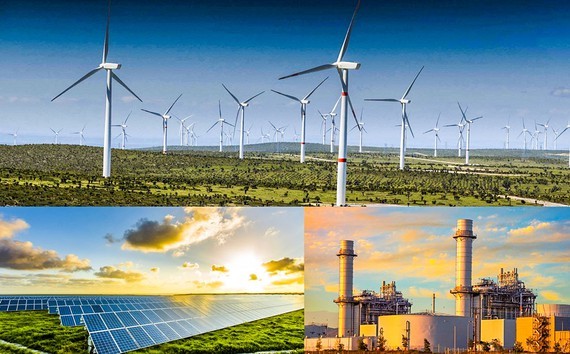
However, in the short and medium-term, Vietnam faces the difficult problem of balancing economic development with environmental protection, as coal power accounts for a large portion of the current energy structure.
Increase in consumption
According to the economic development target set by the National Assembly, the average GDP growth of Vietnam in next five years from 2021 until 2025 is expected to reach about 6.5% to 7%. In order to realize this growth target, it is necessary to ensure energy security, which is an essential input factor for many economic sectors.
Along with the growth and expansion of the economy, Vietnam's energy consumption is increasing rapidly over the years at an average rate of 6% per year, in which electricity consumption alone has increased by about 10%. While the demand for electricity is increasing, the supply capacity is still limited. The latest results calculated by the Institute of Energy under the Ministry of Industry and Trade, for Power Planning project VIII, show that in the base scenario, commercial electricity demand will maintain an increase of 8% in the 2021 to 2030 period. By 2025 it is expected to reach 337.5 billion kWh and by 2030 it is expected to reach around 478.1 billion kWh.
In the short-term general forecast for the period 2021 until 2025, Vietnam faces the risk of power shortage due to delay in the progress of some power plants with larger capacity that are facing some transmission difficulties. The electricity market operates slowly, and the fact that electricity prices do not fully reflect market costs can be seen as the reason why participating partners are not interested, contributing to a gap in energy security.
In the long term, it is forecast that by 2030, Vietnam's population will increase from about 96.7 million people at present to about 104 million people, and the size of the economy will also increase, so the demand for electricity will double that it is today, reaching about 550 to 600 billion kWh. In addition, the ratio of energy consumption demand to GDP growth in Vietnam is twice as high, while in developed countries this ratio is less than 1 times.
Pressure on energy supply
Vietnam has been facing many challenges in ensuring energy security such as the high growth rate of energy demand, which puts pressure on the environmental impact of energy supply activities, especially on coal, in the structure of energy supply and fuel for power generation.
Statistics reported by the Electricity of Vietnam (EVN) show that by the end of the third quarter of 2021, the accumulated electricity output of the whole system will reach 192.55 billion kWh. In which, hydropower will be 54.68 billion kWh at 28.4%; gas turbine will be 20.92 billion kWh at 10.9%; imported electricity will be 1.01 billion kWh at 0.5%; and thermal power mobilized oil will be 2 million kWh. On the other hand, renewable energy such as wind power, solar power, and biomass will still be at a modest 22.68 billion kWh. Coal fired thermal power still accounts for a large portion in the domestic market with 92.67 billion kWh, accounting to 48.1% of the total output of the whole system.
According to the National Power Development Plan 2021 until 2030 with a vision upto 2045 under Power Plan VIII, by 2030 the total installed capacity of power sources is estimated at 137,200 MW, of which coal-fired power will still account for about 27%. By 2035 it will decrease to 23% and continue to decrease to 21% by 2040. In 2045, it is expected that the total installed capacity of the power source will reach 276,700 MW, of which coal fired power plants will still account for 18% of the structure, despite the reduction.
Although coal fired power is causing much concern, the development of this energy source is still necessary in the context of an increasing demand for electricity for the socio-economic development of the country. To meet the demand for electricity at a low cost, the national power system still needs to build coal fired power plants. In the immediate future, if we choose renewable energy, there are likely to be many risks, because this is an unstable energy source due to dependence on the weather, while developing liquefied gas thermal power will be quite expensive and electricity prices will be even higher.
Coal still necessary
According to Power Plan VIII, from now until 2031, Vietnam will build 27 more coal fired power plants, with a total capacity of 31,000MW. According to the Vietnam Energy Institute, the developer of Power Planning VIII, the scale of coal fired power plants put into operation in the 2021 to 2035 period are all projects that are certain to be built, and now being implemented, with good investment promotion which cannot be eliminated. In the context that the development of the power industry must meet electricity demand, ensure national energy security, and minimize environmental pollution, the Power Plan VIII clearly requires coal fired power plants in the period of 2021 until 2025 to only build supercritical coal fired power technology.
However, these projects are currently facing difficulties in raising adequate capital. Accordingly, Vietnam's coal fired power plants for the period 2021 to 2025 need about VND358,000 bn, and for the period 2026 to 2030 they need more than VND425,000 bn for the new construction projects. It is difficult to arrange capital for coal power projects in the coming period because many large financial institutions in the world have restricted lending for coal fired power projects. This is also the main cause of the risk of power shortage due to the slow progress of the source. Recently, there has been a suggestion that coal power plants can convert to liquefied petroleum gas instead of coal. However, this solution is not feasible when liquefied petroleum gas is many times more expensive than coal, and coal fired power plant operators will lose money if they sell power products at the current price.
























